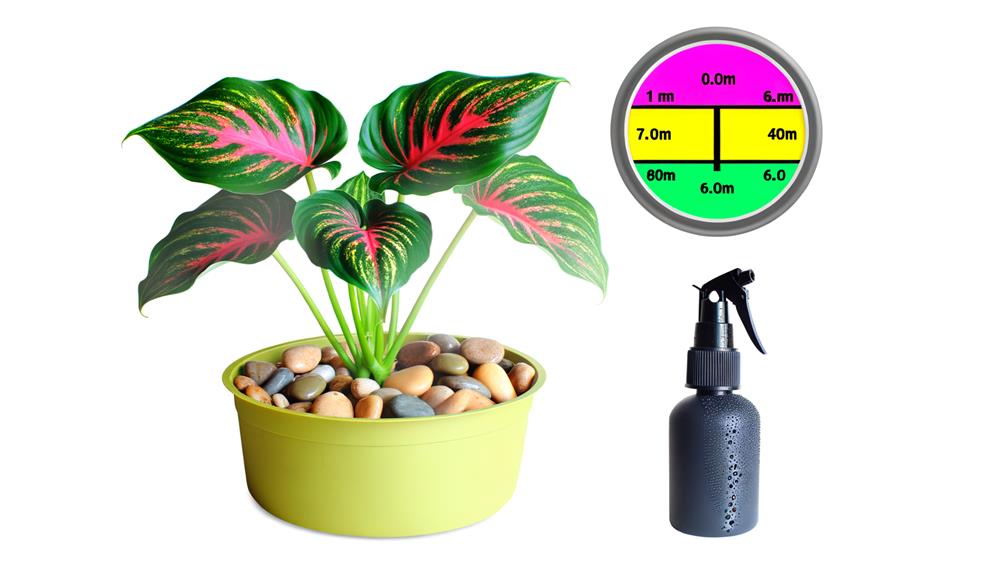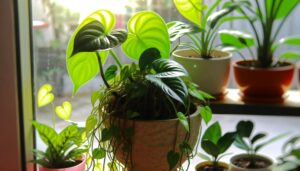Strawberry Shake Philodendron Care
Strawberry Shake Philodendrons thrive in bright, indirect light to prevent leaf burn, whilst promoting healthy growth and coloration. They adapt to both indoor and outdoor environments, favoring a lightweight, peat-based soil mix for aeration and moisture retention.
Regular application of a balanced liquid houseplant fertilizer benefits growth, but beware of over-fertilization. Maintaining moderate humidity with good ventilation helps prevent fungal diseases.
Regular pruning supports health and aesthetics, as does mindful management of pests such as aphids, spider mites, and mealybugs. With closer attention to the plant's unique requirements, one can further optimize its care regimen.

Key Takeaways
- Strawberry Shake Philodendron thrives in bright, indirect light, with artificial lights useful during darker periods.
- Maintain a balance of humidity and ventilation to prevent fungal diseases and moisture accumulation.
- A lightweight, peat-based soil mix with bark and perlite can foster a healthy root environment for the plant.
- Use a balanced liquid houseplant fertilizer with a 20-20-20 N-P-K ratio every 2-4 weeks to nourish growth.
- Regular pruning during the active growth period and managing common pests can ensure robust health and aesthetic appeal.
Understanding Strawberry Shake Philodendron

The Strawberry Shake Philodendron, a hybrid species of the Araceae family, boasts a unique aesthetic appeal with its variegated foliage displaying a remarkable blend of green and creamy pink hues. Its leaves, characterized by their oval shape and pointed tips, often reach a length of 6 to 8 inches, creating a lush, tropical appearance.
This houseplant, while visually enchanting, is also a tribute to the marvels of adaptation and resilience, thriving in diverse environmental conditions. Its roots exhibit a fibrous structure, enabling efficient nutrient absorption and water management. Additionally, the Strawberry Shake Philodendron's capacity to purify air amends the atmosphere of its setting, providing a tangible service to its keepers.
Understanding its characteristics is essential for successful cultivation.
Ideal Light Conditions
The Strawberry Shake Philodendron's growth and health are greatly impacted by the quality of illumination it receives.
It requires a detailed analysis of its ideal light conditions.
To this end, we shall explore the plant's specific light requirements.
We will distinguish between indoor and outdoor lighting scenarios.
Additionally, we will clarify strategies to prevent light-induced damage.
This thorough illumination-focused approach will guarantee that the plant flourishes in its surroundings while maintaining its unique vibrant coloration.
Understanding Light Requirements
Evaluating the best light conditions for the Strawberry Shake Philodendron is essential to its growth and overall health, as this particular species thrives in bright, indirect light.
Exposure to direct sunlight may cause leaf burn, hence, a location with filtered light is ideal.
Light intensity significantly impacts the photosynthesis process, affecting the plant's nutrient absorption and growth rate.
A lack of sufficient light may lead to leggy growth and poor coloration.
Changes in light conditions should be implemented gradually to avoid plant shock.
Understanding these requirements and adjusting light conditions accordingly can make a remarkable difference, ultimately, providing the nurturing environment necessary for this unique philodendron variety to thrive.
Indoor Vs. Outdoor Lighting
Having established the significance of light intensity for the Strawberry Shake Philodendron, it's worth considering the comparative advantages and disadvantages of indoor versus outdoor lighting conditions for this species. Indoor lighting allows for controlled, consistent conditions, minimizing risks of light-related stressors like extreme sunlight or sudden darkness. However, it may require specialized equipment to achieve the ideal luminosity.
Outdoor lighting, on the other hand, can provide a wide spectrum of natural light, beneficial for the plant's photosynthesis process. Yet, it exposes the plant to unpredictable weather changes and potential light fluctuations.
In both scenarios, the key is to provide the plant with bright, indirect light, as direct sunlight can cause leaf burn. The Strawberry Shake Philodendron's adaptability makes it suitable for both indoor and outdoor environments, provided its light requirements are met.
Preventing Light Damage
To prevent light damage and promote growth, it is essential to understand the ideal light conditions for the Strawberry Shake Philodendron. This plant species thrives in medium to bright indirect light.
Avoid Direct Sunlight: Direct sunlight can cause leaf burn or scorching. Guarantee your plant is placed in a location where the sunlight is diffused or filtered.
Monitor Light Intensity: Understand that the intensity of light can change with the seasons or the position of the sun. Regular monitoring and adjustments are necessary.
Rotate Your Plant: Rotate your plant every few weeks to secure all sides receive equal exposure, promoting balanced growth.
Use Artificial Lights: During dark winter months, consider using grow lights to supplement natural light. Remember, your aim is to mimic the soft, dappled sunlight of a tropical rainforest floor.
Watering Requirements

Understanding the watering needs of the Strawberry Shake Philodendron is essential for its overall health and well-being.
This discussion will focus on determining the ideal watering frequency for this plant species, based on various environmental and physiological factors.
We will also address strategies to prevent the detrimental effects of overwatering, including root rot and reduced plant vigor.
Ideal Watering Frequency
One must consider the delicate balance of moisture when cultivating the Strawberry Shake Philodendron, as its watering requirements hinge upon several important factors such as temperature, humidity, and the plant's growth phase.
The ideal watering frequency can be determined by considering the following:
- Temperature: Higher temperatures increase evapotranspiration rates, necessitating more frequent watering.
- Humidity: High humidity levels can reduce the plant's water consumption, thereby reducing watering frequency.
- Growth Phase: During active growth phases, the plant requires more water. As a result, watering should be more frequent.
- Season: Generally, in the warmer growing season, watering should be done more often compared to the cooler dormant season.
Preventing Overwatering Damage
While maintaining a perfect watering frequency is key, it's equally important to prevent overwatering damage in the Strawberry Shake Philodendron as excessive water can lead to detrimental consequences such as root rot. Overwatering can cause the roots to suffocate and decay, hindering the plant's ability to absorb nutrients and eventually leading to its decline.
The table below presents some practical tips to prevent overwatering damage:
| Prevention Measure | Rationale |
|---|---|
| Use well-draining soil | Facilitates excess water discharge |
| Avoid waterlogging | Prevents root suffocation |
| Monitor soil moisture | Guarantees appropriate water levels |
| Allow soil to dry between watering | Prevents root rot |
| Adapt watering to seasonal needs | Avoids excess water in cooler seasons |
Taking such precautions will secure a healthy and thriving Strawberry Shake Philodendron, thereby providing you the satisfaction of successful gardening.
Preferred Temperature Range
The Strawberry Shake Philodendron thrives in a temperature range of 65-80°F (18-27°C), with slight fluctuations posing no significant threat to its health. However, to ensure optimal development and essentiality, certain temperature-related factors should be observed.
- Avoid sudden temperature shifts: Abrupt, extreme changes can stress the plant, potentially causing leaf drop. Gradual adjustments are best.
- Steer clear of frost: Exposure to temperatures below 50°F (10°C) can lead to detrimental effects, including slowed growth and possible frost damage.
- Provide warmth during growth periods: Higher temperatures, within the preferred range, encourage active growth during spring and summer.
- Maintain cooler temperatures in dormant periods: During fall and winter, slightly cooler temperatures can mimic the plant's natural environment, promoting healthier dormancy and future growth.
Humidity Needs

Strawberry Shake Philodendron, like many tropical plants, thrives in high humidity environments, reflecting its natural rainforest habitat. Maintaining a humidity level of 65% to 80% is essential for its best growth. The key is to simulate the plant's native conditions and avoid sudden changes in humidity that can induce stress responses.
Misting the leaves daily or using a humidity tray can help maintain the desired humidity level. However, long-term exposure to excessive moisture can lead to fungal diseases. Therefore, it's important to balance humidity needs with proper ventilation.
The plant should be kept in a well-ventilated area with good air circulation to prevent the accumulation of excessive moisture. This care approach will encourage healthy growth while mitigating disease risks.
Types of Soil Mix
Moving from humidity requirements, another significant aspect of Strawberry Shake Philodendron care involves the selection of an appropriate soil mix. The right mix will ensure optimal growth, health, and vitality of your plant.
Lightweight Mix: A lightweight, well-draining mix allows roots to breathe and promotes healthy root development.
Peat-Based Mix: Peat moss enhances soil aeration and retains moisture, perfect for the essential-loving Strawberry Shake Philodendron.
Bark and Perlite: Components such as bark and perlite provide the necessary drainage to prevent waterlogging and root rot, while also contributing to soil aeration.
Organic Matter: Rich organic matter feeds the roots, supplying essential nutrients for lush, vibrant growth.
Choose thoughtfully, and you'll foster a thriving environment for your Strawberry Shake Philodendron.
Fertilizer Recommendations

In our pursuit to maintain the plant's robust health, selecting an ideal fertilizer for your Strawberry Shake Philodendron is a task of paramount importance.
A balanced liquid houseplant fertilizer, with an N-P-K ratio of 20-20-20, is highly recommended. This provides essential nutrients in equal amounts, promoting overall plant health.
During the growing season, the plant benefits from a high-phosphorus fertilizer to support vigorous leaf growth and stem development. A diluted solution, applied every two to four weeks, is often sufficient.
Caution is warranted, as excess fertilizer can lead to salt buildup, causing leaf burn. Consequently, regular flushing of the soil is also advised.
Repotting Guidelines
Shifting your Strawberry Shake Philodendron to a larger pot is a critical part of plant care that demands close attention to detail and a deep understanding of the plant's specific needs. Repotting is not simply a relocation; it's an opportunity to rejuvenate the plant, optimize root health, and enhance the overall growth trajectory.
To guarantee a successful repotting process, consider these guidelines:
- Choose a pot that is 2-3 inches larger in diameter than the current one. It provides space for growth without overwhelming the plant.
- Use a high-quality potting mix rich in organic matter. It offers the necessary nutrients and promotes good drainage.
- Carefully extract the plant from the old pot, minimizing root damage.
- Position the plant in the center of the new pot, cover with soil, and water immediately.
Pruning Techniques

Pruning, an important aspect of Strawberry Shake Philodendron maintenance, involves the strategic removal of specific parts of the plant to stimulate healthy growth, guarantee structural integrity, and enhance aesthetic appeal. Employing a stake for support, prune to remove any discolored or drooping leaves which often indicate disease or stress.
Cut just above a leaf node, the point where a leaf or branch connects to the stem, to promote new branch growth. Regular pruning not only contributes to the plant's robust health, but also allows the caregiver to shape the plant according to personal preference or space limitations.
Use sterilized equipment to prevent disease transmission and remember that the best time for pruning is during the plant's active growth period, usually in spring or summer.
Managing Common Pests
Managing common pests is an essential aspect of Strawberry Shake Philodendron care. This segment will focus on the identification of common pests that threaten the health of this plant and the implementation of effective pest control strategies.
The objective is to provide scientific and analytical insights to help maintain the plant's wellbeing and aesthetic appeal.
Identifying Common Pests
Occasionally, your Strawberry Shake Philodendron may become a host to common pests such as aphids, spider mites, and mealybugs, which can adversely affect its health and growth. To mitigate such detrimental effects, it's vital to identify these pests early.
- Aphids: These tiny insects are usually green or black and tend to cluster on new growth. They suck plant sap, causing distorted growth and yellowing leaves.
- Spider Mites: These micro-pests are almost invisible to the naked eye. They cause yellow speckles on leaves, and if infestation is severe, you may notice fine webbing.
- Mealybugs: These white, cottony insects suck plant juices, leading to stunted growth and yellowing leaves.
- Thrips: These minute, slender insects cause silvery streaks or spots on leaves and can spread viral plant diseases.
Understanding these pests is the first step towards maintaining the health of your Strawberry Shake Philodendron.
Effective Pest Control
To maintain the robust health and vibrant growth of your Strawberry Shake Philodendron, an effective pest control strategy, grounded in scientific research and proven horticultural practices, is essential.
The most common pests include aphids, spider mites, and mealybugs. These pests can be controlled effectively using a two-pronged approach: preventive measures and active intervention.
Regular inspection of the plant, especially the undersides of leaves, can help detect an infestation early. Using a mild, organic insecticide soap can deter pests without harming the plant or the environment.
For severe infestations, a stronger pesticide may be necessary, but should be used with caution. Pests can build resistance to pesticides, so rotating products and adhering to the recommended application frequency is vital.
Dealing With Potential Diseases

Potential diseases pose a significant risk to the health of a Strawberry Shake Philodendron, requiring watchful monitoring and proactive measures for prevention and treatment.
Root Rot: Overwatering or poor drainage can lead to this fatal disease. Signs include yellowing leaves and soft, mushy roots.
Leaf Spot: This manifests as brown or black spots on the leaves, often surrounded by a yellow halo. It's caused by a variety of bacteria and fungi.
Blight: Rapid browning and death of leaf tissue indicate this infection. Quick isolation and treatment are essential.
Powdery Mildew: Recognizable by white, powdery spots on leaves. Proper air circulation can prevent its spread.
Understanding these diseases, their symptoms, and potential treatments is crucial in maintaining the health and vibrancy of your philodendron.
Make sure you provide a nurturing environment to prevent these diseases.
Conclusion
To sum up, the distinctive and enchanting Strawberry Shake Philodendron requires a specific set of conditions for best growth and development. By following these researched guidelines for light, water, temperature, humidity, repotting, pruning, pest management, and disease prevention, one can successfully nurture this plant to its full, vibrant potential.
A tribute to nature's complexity, the success in caring for this beautiful plant is truly a rewarding triumph over the maze of horticultural science.






